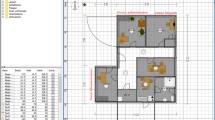Abstract
Some nonverbal signals, like gestures, are not available in computer-supported communication based on audio and textual messages. Therefore computer-supported collaborative learning (CSCL) is subjected to restrictions concerning the process of communication. The effects of nonverbal signs and their relevance in collaborative virtual environments are reported. An experimental study was performed to investigate the effects of the availability of nonverbal signs on the communication process, performance measures and subjective ratings regarding the 3D virtual environment and the communication. Differences concerning objective communication variables, such as number of interruptions, did not reach the level of statistical significance. Providing nonverbal signs in collaborative virtual environments, however, leads to higher motivation and a smoother communication process. The results are discussed with regard to CSCL applications.
Access this chapter
Tax calculation will be finalised at checkout
Purchases are for personal use only
Preview
Unable to display preview. Download preview PDF.
Similar content being viewed by others
References
Argyle, M.; Lalljee, M. & Cook, M. (1968). The effects of visibility on interaction in a dyad. Human Relations, 21, 3–11.
Beattie, G. W. (1981). The regulation of speaker turns in face-to-face conversation: Some implications for conversation in sound-only communication channels. Semiotica, 34, 55–70.
Beattie, G. W. & Barnard, P. J. (1979). The temporal structure of natural telephone conversations (directory enquiry calls). Linguistics, 17, 213–230.
Bente, G. & Krämer, N. C. (2001). Psychologische Aspekte bei der Implementierung und Evaluation nonverbal agierender Interface-Agenten. In H. Oberquelle, R. Oppermann & J. Krause (Hrsg.). Mensch und Computer 2001 (S. 275–285). Stuttgart: Teubner.
Boyle, E. A., Anderson, A. H. & Newlands, A. (1994). The effects of visibility on dialogue and performance in a cooperative problem solving task. Language and Speech, 37(1), 1–20.
Burgoon, J. K. (1986). Nonverbal signals. In M. L. Knapp & G. R. Miller (Eds.), Handbook of interpersonal communication (pp. 344–390). Beverly Hills, CA: Sage.
Clark, H. H. & Brennan, S. E. (1991). Grounding in Communication. In L. B. Resnick, J. M. Levine & S. D. Teasley (Eds.), Perspectives on Socially Shared Cognition (pp. 127–149). Washington, D.C.: American Psychological Association.
Dance, F. E. X. (1970). The „Concept“ of Communication. The Journal of Communication, 20, 201–210.
Delhees, K. H. (1994). Soziale Kommunikation. Opladen: Westdeutscher Verlag.
Doherty-Sneddon, G., Anderson, A., O’Malley, C., Langton, S., Garrod, S. & Bruce, V. (1997). Face-to-Face and Video-Mediated Communication: A Comparison of Dialogue Structure and Task Performance. Journal of Experimental Psychology: Applied, 3(2), 105–125.
Duncan, S. Jr. (1969). Nonverbal Communication. Psychological Bulletin, 72(2), 118–137.
Duncan, S. D. Jr. (1972). Some Signals and Rules for Talking Speaking Turns in Conversation. Journal of Personality and Social Psychology, 23(2), 283–292.
Duncan, S. Jr. & Fiske, D. W. (1977). Face-to-Face Interaction: Research, Methods, and Theory. Hillsdale, N.J.: Lawrence Erlbaum.
Ekman, P., & Friesen, W. V. (1969a). The Repertoire of Nonverbal Behavior: Categories, Origins, Usage, and Coding. Semiotica, 1, 49–98.
Johnson, W. L., Rickel, J. W. & Lester, J. C. (2000). Animated pedagogical agents: Face-to-face interaction in interactive learning environments. International Journal of Artificial Intelligence in Education, 11, 47–78.
Kendon, A. (1967). Some functions of gaze-direction in social interaction. Acta Psychologica, 26, 22–63.
Kiesler, S., Siegel, J. & McGuire, T. W. (1984). Social psychological aspects of computer-mediated communication. American Psychologist, 39(10), 1123–1134.
Larson, J. R. & Christensen, C. (1993). Groups as problem-solving units: Toward a new meaning of social cognition. British Journal of Social Psychology, 32, 5–30.
Lasswell, H. D. (1948). The Structure and Function of Communication in Society. In L. Bryson (Ed.), The Communication of Ideas (pp. 37–51). New York: Harper & Row.
McGrath, J. E. & Hollingshead, A. E. (1993). Putting the “group” back in group support systems: some theoretical issues about dynamic processes in groups with technological enhancements. In L. N. Jessup & J. S. Valacich (Eds.), Group support systems: New perspectives (pp. 78–96). New York: Macmillan.
Müller, K., Troitzsch, H. & Renkl, A. (2003). Der Einfluss nonverbaler Signale auf den Kommunikationsprozess in einer kollaborativen virtuellen Umgebung. Zeitschrift für Medienpsychologie, 15(1), 24–33.
Patterson, M. L. (1990). Functions of nonverbal behavior in social interaction. In H. Giles & W. P. Robinson (Eds.), Handbook of language and social psychology (pp. 101–120). Chichester: John Wiley.
Rutter, D. R. & Stephenson, G. M. (1977). The role of visual communication in synchronising conversation. European Journal of Social Psychology, 7(1), 29–37.
Sacks, H., Schegloff, E. A. & Jefferson, G. (1974). A simplest systematics for the organisation of turn-taking for conversation. Language, 50, 696–735.
Short, J., Williams, E. & Christie, B. (1976). The Social Psychology of Telecommunications. London: Wiley.
Spears, R., & Lea, M. (1992). Social influence and the influence of the “social” in computer-mediated communication. In M. Lea (Ed.). Contexts of computer-mediated communication, (pp. 30–65). New York: Harvester Wheatsheaf.
Walther, J. B. (1992). Interpersonal Effects in Computer-Mediated Interaction. Communication Research, 19(1), 52–91.
Author information
Authors and Affiliations
Editor information
Editors and Affiliations
Rights and permissions
Copyright information
© 2003 Springer Science+Business Media New York
About this chapter
Cite this chapter
Allmendinger, K., Troitzsch, H., Hesse, F.W., Spada, H. (2003). Nonverbal Signs in Virtual Environments. In: Wasson, B., Ludvigsen, S., Hoppe, U. (eds) Designing for Change in Networked Learning Environments. Computer-Supported Collaborative Learning, vol 2. Springer, Dordrecht. https://doi.org/10.1007/978-94-017-0195-2_52
Download citation
DOI: https://doi.org/10.1007/978-94-017-0195-2_52
Publisher Name: Springer, Dordrecht
Print ISBN: 978-90-481-6321-2
Online ISBN: 978-94-017-0195-2
eBook Packages: Springer Book Archive




